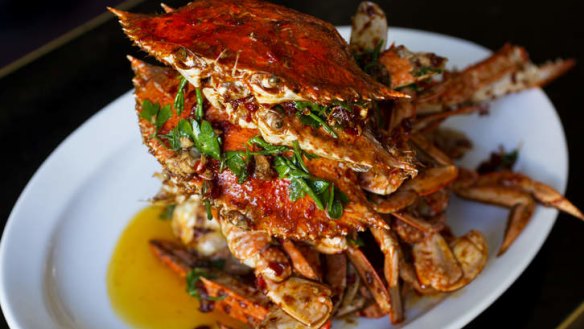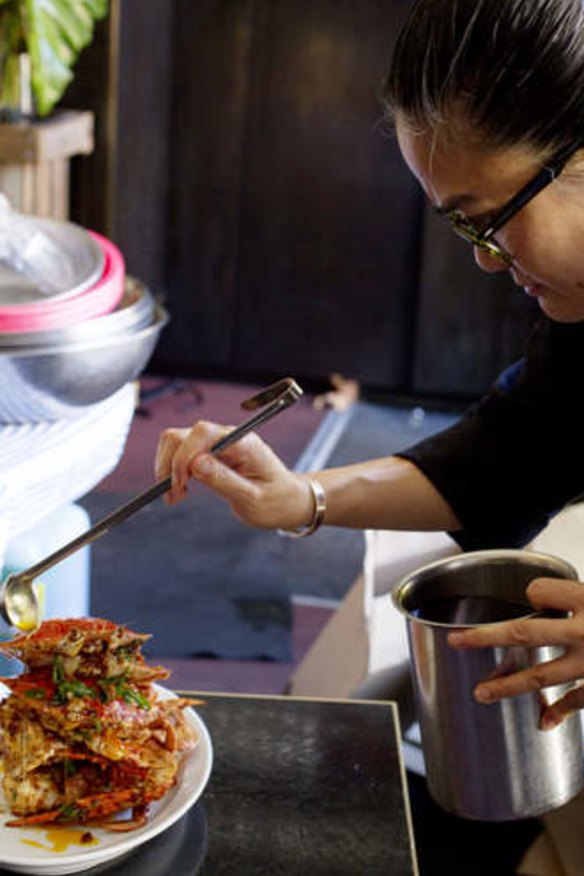Kylie Kwong's Australian-Chinese New Year feast

Chinese New Year, or the Lunar New Year, is the most important of the annual Chinese holidays. It is the time of the world's largest human migration, when migrant workers in China as well as Chinese all over the world, travel home to feast with their families. I celebrate with my family too. My mother has 10 brothers and sisters, so we always have a large and noisy gathering with food at its heart. My mother, her sisters and I spend hours together in the kitchen, producing traditional Cantonese dishes such as poached white chicken and steamed fish with ginger and shallots. Uncle Jimmy always offers a large platter of his freshly cooked Hokkien noodles, and my Australian aunty June always brings an enormous pile of prawns. The amount of food prepared at this time is intended to symbolise abundance and wealth for the household. Australian ingredients harmonise so well with Asian flavours, so here I create a special Australian-Chinese New Year feast for you to enjoy.
Stir-fried blue swimmer crab with homemade chilli sauce
I always serve crab as the centrepiece of my Chinese New Year feast. It is such a festive, generous-looking dish, with its bright-red hue symbolising prosperity and good luck.

1kg blue swimmer crabs (if live, place in freezer for 1 hour to put them to sleep)
120g homemade chilli sauce (below)
1 tbsp tamari or light soy sauce
1 tsp brown sugar
1 tbsp peanut oil
15g ginger, finely diced
3 tbsp shao hsing wine or dry sherry
1 tsp sesame oil
1 tsp malt vinegar
15g sea parsley or coriander leaves
20g samphire or mint
1. Prepare the crabs. Prise off the top shell, discard the innards and rinse the shell. Chop the crab body in half. Remove the feathery grey gills. Crack the larger claws with a mallet or the back of a chef's knife. Place in a shallow heatproof bowl in a steamer basket. Place in a steamer over boiling water and steam, covered for seven minutes or until cooked.
2. Combine the chilli sauce, tamari or light soy sauce and sugar in a small bowl, stirring to dissolve the sugar.
3. Heat the peanut oil in a hot wok until the surface seems to shimmer slightly. Add the ginger and stir-fry for 30 seconds.
4. Add the wine or sherry and stir-fry for 30 seconds, then add the chilli sauce mixture and stir-fry for 30 seconds or until the sauce starts to caramelise.
5. Add the sea parsley and samphire to the wok, stir-fry for 10 seconds, then add the crab pieces and their cooking juices and toss well for one minute.
6. Add the sesame oil and vinegar, toss well, then transfer to a large platter and serve immediately.
Homemade chilli sauce
8 large red chillies, roughly chopped
6 garlic cloves, roughly chopped
75g ginger, roughly chopped
125ml peanut oil
½ tsp sugar
1 tbsp tamari or light soy sauce
1. Finely chop the chilli, garlic and ginger in a food processor.
2. Heat the oil in a wok until the surface seems to shimmer slightly. Reduce the heat to low-medium, add the chilli, garlic and ginger and cook, stirring regularly, for about three minutes.
3. Add the sugar and cook for one minute, stirring regularly.
4. Stir in the soy sauce, reduce the heat to low and cook, stirring, for 10 minutes. The sauce should darken in colour and the oil leach out. The chilli sauce can be used immediately or stored in the refrigerator for up to a week.
Makes two or more servings.
Caramelised pork belly with salt bush
We are fortunate to have access to clean-flavoured, high-quality pork in Australia and no Chinese New Year feast is complete without a red-braised pork dish - the juicy, sweet caramelised pork pieces perfectly combine with the naturally salty and creamy salt-bush leaves. Toss the leaves in at the last moment, so they retain their fabric-like texture.
600g pork belly, cut into 2cm cubes
vegetable oil for frying
1 cup (220g) brown sugar
1 cup (250ml) water
2 tbsp fish sauce
juice of 3 limes
25g salt-bush or spinach leaves
Red Braising Stock
3 litres cold water
2½ cups (625ml) shao hsing wine
1½ cups (375ml) tamari or light soy
⅓ cup dark soy
1 cup (220g) brown sugar
6 garlic cloves, crushed
2 x 8 cm pieces (90g) ginger, sliced
4 spring onions, trimmed and cut in half crossways
1 tsp sesame oil
5 star anise
2 cinnamon quills
3 strips orange zest
1. To remove any impurities from the meat, place pork belly in a large pan, cover with cold water and bring to the boil. Simmer for 5 minutes, then drain, discarding water. Rinse pork thoroughly under cold running water and drain well.
2. Place all stock ingredients in a large, heavy-based pan or stockpot and bring to the boil. Reduce heat and simmer gently for 40 minutes to allow the flavours to infuse. Place pork in the stock and simmer gently for 45 minutes or until pork is tender.
3. Remove pork from pot and set aside on paper towels to drain thoroughly. Pour enough vegetable oil for deep-frying into a wok and heat until the surface seems to shimmer slightly (190C). Add half the pork and deep-fry for three minutes or until golden-dark brown, using tongs to turn and separate any pieces that stick together. Remove pork with a slotted spoon; drain well on paper towels. Repeat this method with the remaining pork.
4. Meanwhile, place brown sugar and water in a medium-sized pan and bring to the boil, then allow to caramelise, which will take about six minutes. Add fish sauce and lime juice.
5. Add deep-fried pork pieces to hot caramel sauce and stir to combine. Toss in salt-bush (or spinach) leaves, stir for one minute only; serve immediately.
Serves 4-6 as part of a shared meal.
Stir-fried wallaby tenderloin with black bean and chilli
Many of us have tasted the classic Cantonese dish stir-fried beef with black bean and chilli; this is my take on it.
By using Australia's indigenous meat - delicious wallaby (or you can substitute kangaroo) - this dish becomes part of my Australian-Chinese New Year feast.
300g wallaby tenderloin* cut into 2cm slices (or use kangaroo fillet)
2 tbsp vegetable oil
Black Bean and Chilli Sauce
1 tbsp vegetable oil
1/2 small red onion, finely sliced
1 tbsp ginger, julienned
1 tbsp salted black beans
1 tbsp shao hsing wine or dry sherry
1 tsp white sugar
1 tbsp tamari or light soy
1 tsp malt vinegar
1/2 tsp sesame oil
1 large red chilli, sliced on the diagonal
1. Heat half the oil in a hot wok until surface seems to shimmer slightly. Add half the wallaby and stir-fry for 30 seconds. Remove from wok with a slotted spoon and set aside. Add remaining oil and wallaby and stir-fry for 30 seconds then remove as before and set aside. Clean wok.
2. For the black bean and chilli sauce, heat oil in the hot wok until the surface seems to shimmer slightly. Add onion, ginger and black beans and stir-fry over a high heat for 30 seconds, stirring constantly to ensure black beans do not burn.
3. Return wallaby to the wok with wine or sherry and stir-fry for 30 seconds. Add sugar, tamari or soy sauce, vinegar and sesame oil and stir-fry for a further minute. Lastly, add chilli and stir-fry for a further 30 seconds.
4. Arrange wallaby in a shallow bowl and serve immediately.
Serves 2 or more as part of a shared meal.
*I use Flinders Island wallaby from flindersislandmeat.com.au.
The best recipes from Australia's leading chefs straight to your inbox.
Sign up